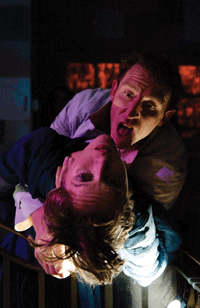Pop in, sit up
The success of recession-fuelled pop-up theatre shows that creativity need not be restrained by budgets, argue Roland Smith and Jessica Brewster

It is almost shameful to admit, but the credit-crunch provided Theatre Delicatessen with its first major breakthrough back in 2007. We had been looking for an alternative space to create a re-imagining of A Midsummer Night’s Dream, when James Bowdidge of the Property Merchant Group offered us a derelict workshop space in the ground floor of a central London office block that was scheduled for redevelopment. As the economy began to fail and the development works were put on hold, a space that we expected to use for one production became our home for over two years.
IT’S THE ECONOMY, STUPID
The economic downturn has created perfect conditions for the pop-up arts movement to flourish. Empty spaces are appearing across cities as shops close or developments are put on hold. There is more to this movement than simply finding low-rent space for struggling artists. At the heart of every pop-up arts event you can sense a hunger to reclaim our shared space by subverting our built environment. So much of our world seems to lie behind closed doors or is out of bounds. It is a wonderfully gentle act of anarchy to take these empty offices and shop-fronts into galleries and theatres and allow the public into a once private world.
This idea of taking something established and turning it on its head was behind the creation of Theatre Souk. Following our residency at 295 Regent Street, we moved to a four-storey college building in Picton Place – sandwiched between Selfridges and St Christopher’s Place on the fringes of London’s most famous shopping street. We wanted to create an artistic response to this strange location whilst at the same time exploring more widely the world of business and commerce.
With Theatre Souk we have created a theatrical market place. Every room in the building has been taken over by a different artist and theatre company to create a performance space or experience. The audience wanders through the building as the different performers try to sell them their wares, haggling over the price and fighting for customers. By working with some of the London’s best emerging and experimental theatre-makers – such as Natural Shocks, dash theatre and Juliane Von Sivers – in the building, we have tried to create a stock exchange of ideas and performance, blurring the lines between customer and audience.
IS POP-UP THEATRE SHALLOW?
Pop-up theatre is sometimes sniffed at for being transient, or shallowly obsessed with ever-new and wilder audience experiences. In truth, it uses existing theatre practice to explore the way in which we create a shared space, exploring the relationship between audience and performer by immersing both in the world of the performance. The two most precious things for a young artist are time and space – time to grow and develop, and space to experiment, to create work and to make mistakes. In many ways the pop-up arts movement represents a rejection of the establishment. It is the equivalent of ticking ‘none of the above’, opting out of the opportunities that exist and creating your own. It is inherently headstrong and arrogant, but at the same time it is about retaining control of your work and choosing not to compromise.
Companies such as Punchdrunk and Shunt have been creating hugely successful theatre for a decade now, and have done so by using pop-up spaces to create a consistent aesthetic throughout all their productions that is very much their own, and that permeates both form and content. HighTide used West 12 shopping centre in Shepherd’s Bush, transforming it to suit just one play, ‘Stovepipe’. The notion of transformation is key to this aesthetic.
Or at least that is the ideal. In reality the term pop-up, with its implications of fun, surprise and immediacy, belies the huge logistical, practical and financial slog that needs to go into creating a working performance space. A derelict or dilapidated building is rarely an easy place to exist comfortably, often lacking basic facilities, heating or safe drinking water. Inevitably, Health and Safety and licensing requirements dominate the process and can have serious implications on the art that is created. There are also business transactions to work out – in our case a very small theatre company negotiating terms of tenancy with a FTSE 500 business. The equivalent, perhaps, of a small minnow from a garden pond approaching a blue whale in the Pacific. But it works.
Join the Discussion
You must be logged in to post a comment.